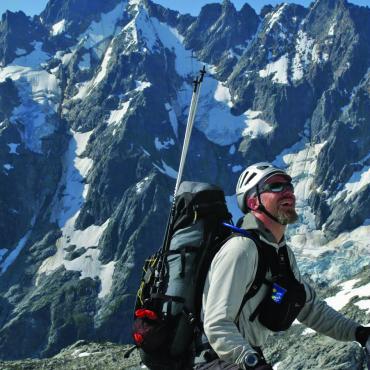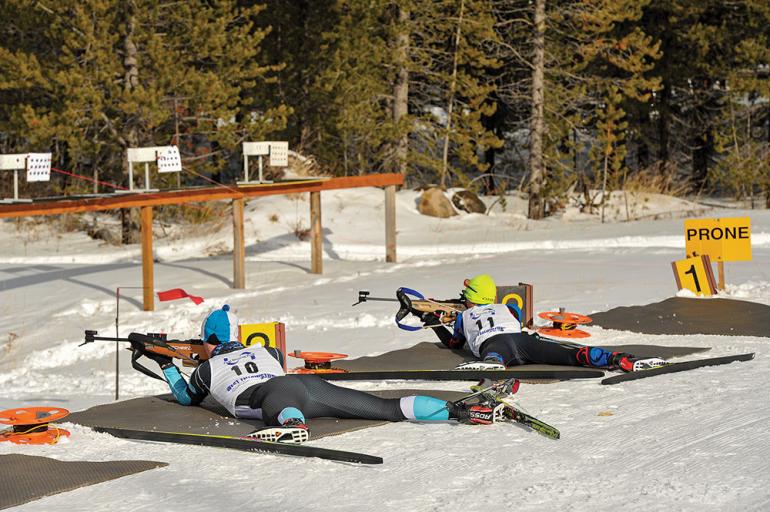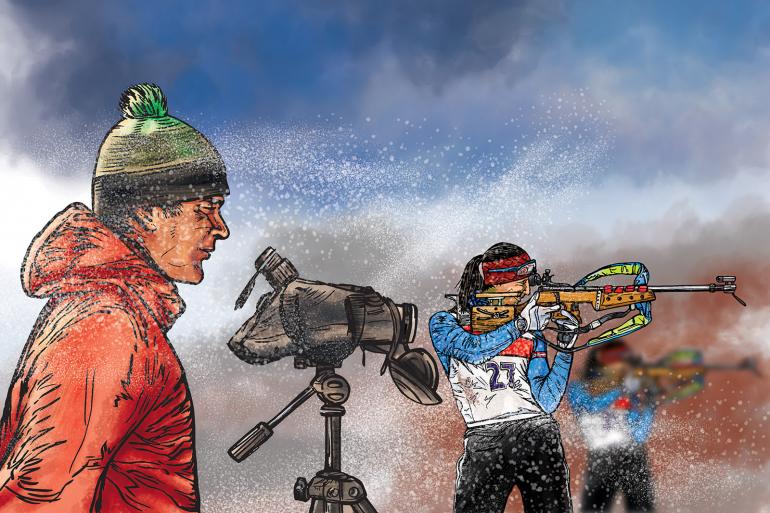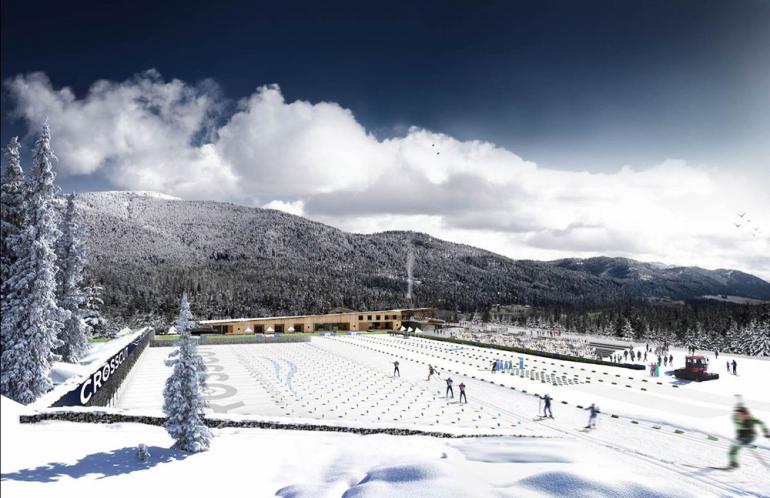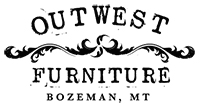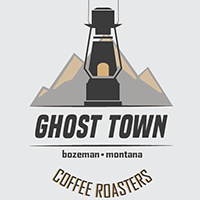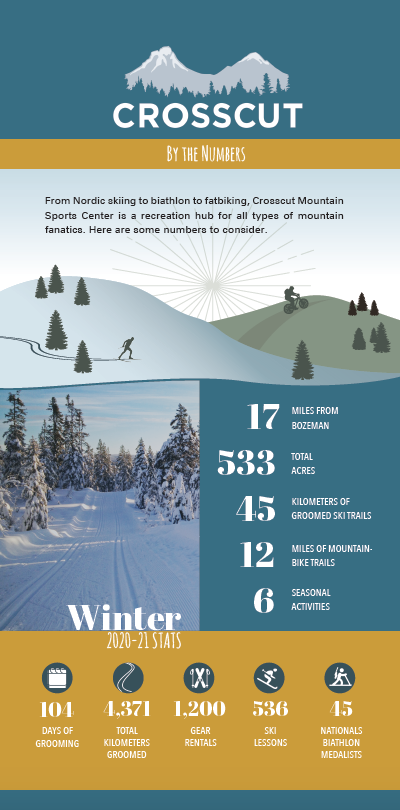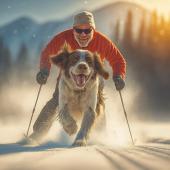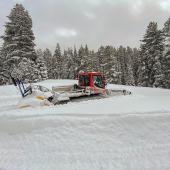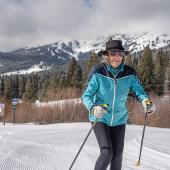Fire & Ice
A Q&A with Crosscut on the growth of biathlon in Bozeman.
Originating in Norway for military training, biathlon—the combination of cross-country skiing and target shooting—was inspired by Ullr, the Norse god of skiing and hunting. The sport demands cardiovascular fitness, strong technical skiing skills, and shooting focus. Biathlon is less well-known in the United States than in Europe, where it’s one of the most-watched winter sports on television. But in Bozeman, it’s getting some attention.
We caught up with Seth Hubbard, program director for Crosscut Mountain Sports Center, to talk about what’s happening with biathlon in southwest Montana. Seth oversees all the biathlon programming at Crosscut, from youth classes (starting at 10 years old) to novice adult programs and elite teams including Paralympic athletes.
O/B: What do you love the most about biathlon?
Seth: I love how engaging it is. Last summer, we did a program with Big Sky Youth Empowerment (BYEP). Even though it wasn’t the typical competitive side of biathlon that we’re used to, all of the BYEP instructors said that it was the most engaged they’d seen their students.
O/B: How does someone get started in biathlon? It requires so many skills.
Seth: Typically, the way people get involved is if they’re lucky enough to live in someplace like Bozeman. We have youth programming available, so people can get an early introduction and be involved competitively at a young age. Another common route is to come in a little bit later through Nordic skiing. Programs often work with athletes that are college-aged, too, which is how I originally got pulled in. I was a Nordic ski racer and came across the development program for biathlon when I graduated from college. When older adults get started for the first time, I find it often comes from wanting a reason to get out and stay active and involved, similar to running or biking races.
O/B: Does Crosscut have any free introductory clinics? How do people take the first step?
Seth: We tend to run one to two clinics per winter, typically right in the middle of November and then in January and February. People can come with no experience—they don’t even have to have experience on skis—and get a chance to have some contact with the sport. All of the community events we run at Crosscut, as well as down in West Yellowstone, have a novice category. We do a quick introductory safety clinic and set up the event so that even somebody who has no experience can participate in a race. For a lot of people, our novice races are where they get their first exposure.
O/B: What are the specific requirements for rifles and ammunition?
Seth: We use the .22 long rifle, which is very similar to anything you might purchase at a local gun shop. It has to be a bolt action, can’t be a semi-automatic or anything to that effect. We’re restricted to five rounds in a magazine. The most popular firearm that people are using is the Anschutz 1827 Fortner Action. The Izmash is becoming less and less prevalent as they are not imported in most places anymore. We see a huge step where people go from spending $200-$300 for a basic .22 rifle, to $5,000 for a competition firearm.
Once you start using them, it’s easy to see that yes, there is functionally quite a difference between the two. But there are a few options spread out in between. Unfortunately, once you start getting more involved with the competition end, the steps forward start to get significant pricewise, which is why we have a lot of club firearms to defray as much of that cost for as long as we can for participants.
We do have a firearm weight restriction and the low limit must clear 3.5 kilograms or 7.7 pounds. There is no upper limit.
Ammunition must be standard velocity. It can’t be a high-velocity round, and that’s due to the targets we’re shooting at. There’s what we call a falling plate, which is a metal plate sitting on a balance point that tips over when it gets hit, as well as electronic targets that use a pressure plate to actuate the paddle to close. A higher velocity bullet creates more impact on the target apparatus and could potentially trigger the pressure plate to close, showing a hit target even if the shooter misses.
O/B: What’s the terrain like on a typical biathlon course?
Seth: Our race distances range from novice three-kilometer courses to Olympic-level 20-kilometer races. The shortest races we do are what we refer to as a two-stage race. We shoot twice and ski three laps. These are our sprint races, relay races, or super-sprint qualifiers, which are newer in competition. We go up to what we call a four-stage race, which is shooting four times and skiing five laps. Specifications on length, elevation, and course-width depend on what sort of race we’re doing.
When they made the switch from large calibers to .22, they also made the switch from traditional classic skiing to freestyle completely. So now all of our races are just skate skiing. I’ve seen people who are good sprint racers who’ve been able to transition into it and I’ve also seen people who are great distance classic skiers that have been able to transition into it.
O/B: What’s the shooting strategy—do you ski slower to get your heart rate down, or shoot between breaths?
Seth: There’s only so much you can do to drop your heart rate. It’s more about training and learning to be able to shoot with a higher heart rate under duress. I hear a lot of comments from people who don’t spend a ton of time around the sport about how incredible it is that people can drop their heart rates just like that to shoot. In reality, they don’t.
O/B: What makes Bozeman such a great spot for biathlon and Nordic skiing in general?
Seth: On the Nordic side, we have a great place for ski-specific training on suitable terrain without having to deal with cars and traffic. It lends itself to having more competitions here locally. That means everything from citizen events all the way to international competitions, both Nordic and biathlon. The international biathlon meets are something we hope to see here before too long.
O/B: What’s happening with the current development going on at Crosscut?
Seth: This summer, we started Phase One of our expansion, on what was the original Crosscut Mountain Ranch years ago. In 2021, we started digging the new comp trail. We went out to what our 3.3k length course will be. We’ll have cut-throughs and connectors that will do everything from the 3.3, to a 3, a 2.3, a 2, a sprint course, a 1k, and an 800-meter para loop as well.
Next summer, our focus is finishing that loop and getting a paved roller-skiing portion ready. So that’s a lot of dirt-moving. As far as biathlon goes, we have a 12-point range that we can’t roller ski on. We’re limited by space. It’s served us well, but this winter is going to be a scheduling game of trying to fit everybody in on it.
Next summer, we’ll be building a 30-point biathlon range. And that stadium that gets built with it is going to be the same stadium that gets used for Nordic competitions and ski lessons during the week. It’ll end up providing a nice big focal point, and with it paved, we’ll be able to use it year-round.
Biathlon Beta
In the late 1950s, early international competitions used high-caliber ammunition on snow courses with targets spread out in a variety of terrain. It was a lot like a modern-day orienteering course. In 1978, the format became a single target range consisting of five round targets distanced at 50 meters, with ski loops of varying length and difficulty. Firearms were standardized to a five-shell cartridge of .22 ammunition, open sights, and a minimum weight limit.
Modern-day biathlon is on fixed courses with single shooting ranges. Each event has a ski lap ranging from 1k-5k, sometimes longer. Each time racers arrive in the shooting arena, they take a shooting stance; either standing (4.5-inch target) or prone (1.8-inch target). The biathlete has a .22 rifle with double slings worn like a backpack.
The rifle must be pointing in the sky or at the target. When skiing into the shooting stadium, athletes remove their poles while steadying their breath. The rifle is quickly rotated from carry into shooting position in a well-rehearsed movement. The biathlete loads the bolt-action rifle with the first round and shoots at one of the five targets. If a target is hit, a satisfying metallic “tink” sound resonates and the target flips from black to white.
As mentioned, the biathlete has five shots to hit five targets on a 50-meter range. If a target is missed, a 150-meter penalty lap must be skied, or a time penalty is added for each missed target. When shooting is finished, the biathlete re-slings the rifle into carry position and exits the shooting area. All skiers utilize the freestyle technique, otherwise known as skating. Courses have a standard percentage of flat terrain and hills. There is typically at least one steep section. Standings are based on time.
Bryan Schaeffer was born in Bozeman where he lives with his wife, three daughters, and an eager-to-adventure goldendoodle. He owns the creative studio SINTR, and when not recreating outside, can be found writing, illustrating, and animating his book series The Last Best Trails. He remains infinitely curious as to what may be lurking around the next switchback, mountain pass, or pitch.

